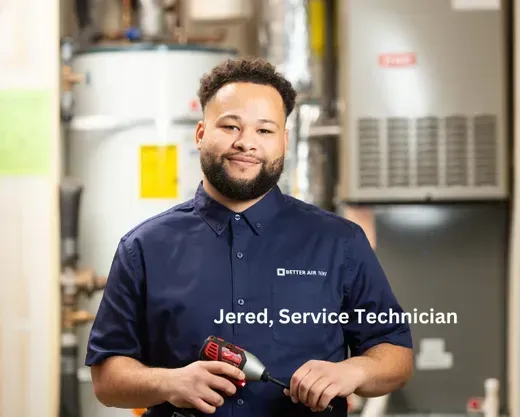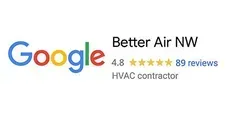Expert HVAC Solutions for Your Home Comfort
Reliable HVAC Services in Everett & Seattle Area
Looking for HVAC services near you? Better Air NW Heating & Cooling provides expert heating and cooling solutions, ensuring year-round comfort for home. From AC repair to furnace installation, our certified technicians deliver reliable and energy-efficient services.
Air Conditioning Services
AC Installation & Replacement »
Air conditioners, consisting of an indoor unit and an outdoor unit, are the cornerstone of modern cooling systems. These units work by removing heat and humidity from the indoor air and transferring it outside, ensuring a comfortable and cool environment within your home. Central air conditioning systems are particularly popular for their ability to cool multiple rooms simultaneously through a network of ducts, providing cooled air throughout the space.
Central air conditioning systems come in three main types:
- Single-stage systems operate simply by being either on or off, offering a straightforward cooling option but with less energy efficiency.
- Two-stage systems enhance energy efficiency by operating at a lower speed during milder weather and increasing speed during peak heat.
- Variable-speed systems are the most advanced, continuously adjusting fan speed and cooling output to maintain stable indoor temperatures and maximize energy savings.
Selecting the right air conditioning system depends on your needs, budget, and home layout. Our HVAC professionals can help determine the best fit, ensuring optimal performance and energy efficiency.
Furnace Services
Furnace Installation & Replacement »
Furnaces are the backbone of heating systems in many homes, generating warmth by burning fuel such as natural gas or propane. The heat produced from combustion is transferred to air via a heat exchanger and then distributed throughout the home to maintain a comfortable indoor temperature, often supplemented by supplemental heat.
There are different types of furnace systems:
- Single-stage furnaces operate at full capacity or not at all, offering simplicity but less control over indoor temperatures.
- Two-stage furnaces can run at a lower setting for mild weather, providing better efficiency and comfort.
- Modulating furnaces adjust their heat output in small increments, ensuring precise temperature control and maximum energy efficiency.
Furnaces are essential for maintaining home comfort during colder months. Their ability to provide reliable and consistent heat makes them a staple in many households. Consider factors such as fuel type, efficiency ratings, and home size when selecting a furnace to ensure optimal performance.
Heat Pump Services
Heat Pump Installation or Replacement »
Heat pumps are versatile systems that can provide both heating and cooling by reversing the flow of refrigerant. This dual functionality makes them an excellent choice for year-round climate control. During the summer, heat pumps remove heat from your home, while in the winter, they extract heat from the outside air and bring it indoors—even in cold temperatures.
Heat pumps come in various types:
- Single-stage heat pumps operate at a fixed capacity.
- Two-stage systems offer better efficiency by adjusting their output based on demand.
- Variable-speed heat pumps provide the highest level of efficiency and comfort by continuously modulating their output to match the heating or cooling needs of your home.
Heat pumps can be part of dual-fuel systems, where an electric heat pump handles moderate temperatures and a gas furnace takes over during extreme cold, enhancing efficiency. This combination ensures optimal performance and energy savings throughout the year.
Ductless Mini-Split Services
Mini-Split Installation & Replacement »
Currently Servicing Only Mitsubishi Systems.Ductless mini-split systems are an ideal solution for homes without existing ductwork or for those looking to customize the climate control in individual rooms. These systems consist of an outdoor condenser and multiple indoor units, allowing for targeted heating and cooling.
The installation process involves mounting the indoor units in the desired locations, installing the outdoor unit, and connecting them via refrigerant conduits. This setup not only provides flexibility in terms of placement but also enhances energy efficiency by avoiding the losses associated with ductwork.
Ductless mini-split systems are especially useful for additions, renovations, or homes where traditional central HVAC systems are impractical. Their ability to offer personalized comfort in different zones makes them popular among homeowners.
Air Duct Cleaning
Customer Reviews & Testimonials
⭐ ⭐ ⭐ ⭐ ⭐
"Best HVAC service in Seattle! They fixed my AC fast and affordably." – Aaron S.
Top HVAC Solutions for Home Comfort and Efficiency
HVAC stands for Heating, Ventilation, and Air Conditioning. These technologies are crucial for home comfort. This article covers various options such as air conditioners, furnaces, heat pumps, and ductless mini-splits. Learn how to choose the best system for your home and the benefits of upgrading.
Key Takeaways
- Heating, ventilation, and air conditioning are essential for maintaining indoor comfort and air quality, with various types tailored for specific needs.
- Upgrading to newer models offers significant benefits, including reduced energy costs, improved indoor air quality, and consistent heating and cooling performance.
- Energy efficiency ratings, like SEER and EER, are critical in selecting the right unit, and optimizing usage with smart technologies further enhances energy savings.
Understanding Heating and Cooling Systems
HVAC stands for Heating, Ventilation, and Air Conditioning, a trio of technologies that work together to maintain the comfort and safety of indoor environments. These systems regulate temperature, humidity, and air quality, keeping your home comfortable regardless of the weather outside. They also ensure the circulation of fresh air, which is crucial for maintaining healthy indoor environments.
Families depend on reliable heating and cooling for comfort and well-being, as various components manage indoor conditions effectively. Mechanical ventilation plays a vital role in promoting regular air exchange, especially in tightly insulated homes. From air conditioning units that cool the house during sweltering summers to furnaces that provide warmth in the winter, these technologies are an integral part of modern living. By facilitating the exchange of stale air for fresh air, they significantly improve indoor air quality.
There are multiple types of heating and cooling solutions, each designed to cater to specific needs and installation scenarios. Next, we explore the main types: air conditioners, furnaces, heat pumps, and ductless mini-split systems. Each has unique features, benefits, and considerations to help you choose the best option for your home.
Benefits of Upgrading Your System
Upgrading to a newer model offers numerous benefits beyond improved comfort. One immediate advantage is reduced monthly utility costs due to enhanced energy efficiency. Modern units often incorporate advanced ventilation features that ensure a steady supply of fresh air, enhancing indoor air quality. Newer designs are built to use less energy while delivering superior performance, translating to significant savings on your energy bills.
In addition to financial savings, an upgraded unit can provide better indoor air quality. Many come equipped with advanced filtration and humidity control features, ensuring a healthier living environment. This leads to improved well-being and productivity, as clean air and consistent temperatures enhance overall comfort and health.
Modern equipment provides more consistent and reliable heating and cooling, eliminating uneven temperatures and frequent breakdowns. This reliability ensures that your home remains comfortable year-round, regardless of the weather outside.
Energy Efficiency in Climate Control
Energy efficiency is a key factor when selecting a heating and cooling unit. Efficient models reduce energy consumption and lower utility bills, making them cost-effective in the long run. High-efficiency units minimize environmental impacts and may qualify for rebates and incentives.
Understanding efficiency ratings helps in making informed decisions. SEER (Seasonal Energy Efficiency Ratio) for air conditioners and EER (Energy Efficiency Ratio) for cooling systems indicate how efficiently a system operates under specific conditions. Higher ratings mean better performance and lower energy consumption.
Optimizing energy usage, in addition to selecting high-efficiency models, can further enhance savings. Smart thermostats adjust temperature settings based on usage patterns, and enhanced air sealing and insulation prevent energy wastage. These measures ensure optimal operation, providing comfort without high costs.
Choosing the Right System for Your Home
Selecting the best unit involves considering your location, home size, budget, and personal comfort preferences. Evaluating these factors ensures the chosen model meets your specific needs and provides the desired level of comfort.
Energy efficiency, noise levels, and humidity control are crucial features to consider. High-efficiency units can offer significant energy savings, while quiet operation and effective humidity control contribute to a more comfortable living environment.
Financial incentives and rebates may be available for upgrading to newer, more efficient models, making the transition more affordable. HVAC professionals can help navigate these options and select the best system for your home.
Installation Process
Installation involves several critical steps to ensure a successful setup. It starts with assessing your current system and performing a load calculation to determine the appropriate size of the new unit. This step ensures the system can effectively meet your home’s heating and cooling demands.
Once the planning phase is complete, the installation process includes removing the old system, setting up the new components, and connecting electrical and refrigerant lines. Compliance with local building codes during this stage guarantees the safety and legality of the installation.
After installation, thorough testing verifies proper operation and efficiency. Choosing a qualified contractor who offers comprehensive services, including installation, repair, and maintenance, ensures optimal performance and longevity.
Additional Indoor Air Quality Solutions
In addition to traditional heating and cooling, there are several other solutions that can be used to improve indoor air quality and comfort. Some of these solutions include:
- Air Cleaners and Purifiers: These devices remove contaminants like dust, pollen, and pet dander. Advanced models can also eliminate bacteria, viruses, and VOCs (volatile organic compounds), significantly improving air quality.
- Humidifiers and Dehumidifiers: Maintaining optimal humidity levels is crucial for comfort and health. Humidifiers add moisture to the air in dry climates or during winter months, preventing respiratory issues and dry skin. Conversely, dehumidifiers reduce excess moisture in humid climates, preventing mold growth and enhancing comfort.
- Mechanical Ventilation Systems: These systems ensure a continuous supply of fresh air while expelling stale air. They are particularly beneficial in tightly sealed homes where natural ventilation is limited. By promoting air exchange, mechanical ventilation enhances indoor air quality and comfort.
- Smart Thermostats: These devices allow for precise control over your home's temperature, optimizing energy usage and comfort. Smart thermostats can learn your schedule and preferences, automatically adjusting settings to maintain ideal conditions while maximizing energy efficiency.
- Zoning Systems: Zoning divides your home into different areas, each with its own temperature control. This setup allows for customized comfort in various parts of the house, ensuring that each room is heated or cooled according to individual preferences.
By incorporating these solutions, homeowners can enhance their indoor environment, ensuring a healthier and more comfortable living space.
Maintenance Tips
Proper maintenance ensures efficiency and longevity. Changing filters every 30-90 days maintains good air quality and system performance. Dirty filters hinder airflow and increase energy costs, so regular inspection and replacement are necessary.
Seasonal inspections in spring and fall help identify and address potential issues before they escalate, ensuring effective year-round operation. Annual pre-season check-ups by a professional prevent breakdowns and ensure efficient performance.
Maintenance tasks also include cleaning evaporator and condenser coils to enhance heat exchange efficiency and inspecting ductwork every 3-5 years to remove dust and mold. Sealing ductwork improves heating and cooling efficiency by reducing air leaks.
Summary
In summary, understanding the different types of heating and cooling solutions and their benefits can help you make informed decisions for your home. Upgrading to a newer system offers numerous advantages, including energy savings, improved air quality, and enhanced comfort. Ensuring efficiency through high-efficiency ratings and optimizing energy usage can further reduce costs and environmental impacts.
The installation process requires careful planning and professional execution to ensure compliance and optimal performance. Choosing the right model involves considering various factors such as home size, budget, and personal preferences. Proper maintenance is essential for sustaining efficiency and longevity, contributing to better indoor air quality and overall comfort.
We encourage you to consult with one of our Project Managers to explore the best options for your home and ensure that your system is well-maintained for years to come. Your comfort is our priority, and we are here to assist you every step of the way.









